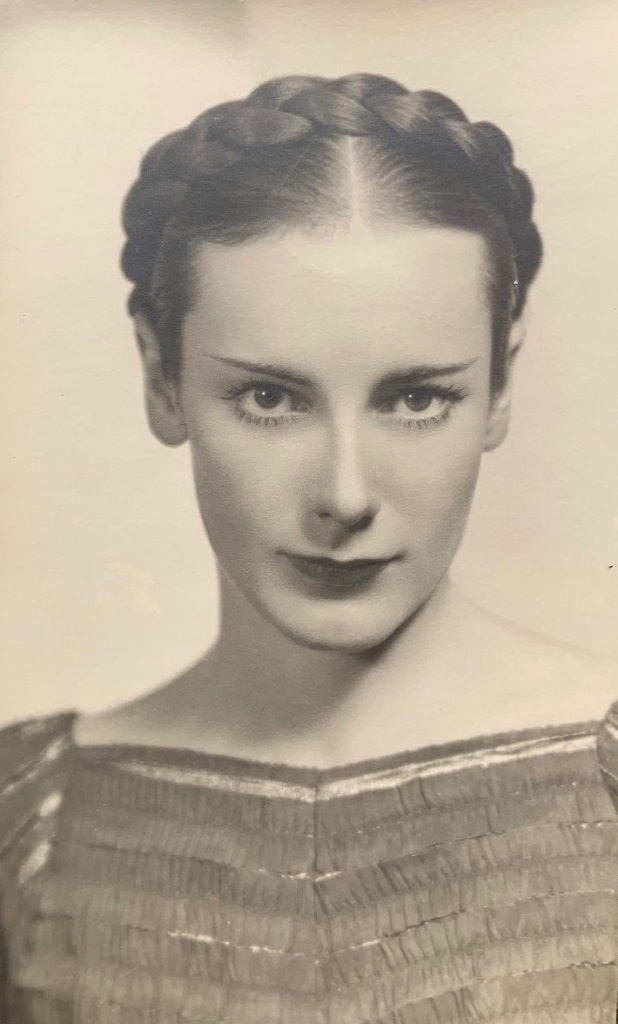
 |
Floor Plan |  |
The Dennis Wheatley 'Museum' - Champions of Reincarnation: Dennis Wheatley & Joan Grant
Joan Grant dictates 'Winged Pharaoh'
Joan Grant
Click on the image to enlarge
Continuing the story of Joan Grant's life, in September 1936 with her husband back from Iraq, the couple and their daughter went down to stay with the Sartorius sisters at Hurtwood.
Daisy Sartorius was just recovering from a cancer operation, and in the evenings to pass the time they played card games or completed complicated jigsaw puzzles until one evening Leslie suggested Joan psychometrise something, and asked if they had anything Egyptian.
Elfie commented that they had some scarabs, which had been given to their late brother when the family visited Egypt in 1892.
There were five of them, and for some reason Joan decided that a turquoise blue one was to be 'done' last. The others having proved genuine but of no real interest, Joan pressed the last to her forehead, and as she wrote in 'Time Out of Mind' (page 227) :
"The moment it touched my forehead I knew it was warm and lively ... This one is much older than any of the others. It was taken from the mummy of a priestess ..."
She quickly refined this to say that it did not come from a dead mummy but from a living girl / priestess called Sekeeta who was undergoing a trial of initiation.
As time went by Joan brought back other fragments, written down first of all by her husband Leslie in his own unique form of shorthand, and later by her secretary Vera Sutherland.
The over a hundred episodes that made up 'Winged Pharaoh' did not come out in chronological order, and had to be put in the right order - as far as they could be - later and painstakingly, like a giant jigsaw puzzle.
During the stage when the book was being assembled from its constituent parts, Joan recounted in 'Time Out Of Mind' how the family doctor, Dr Marr, dropped round with a friend - Sir Henry Wood of Proms fame - and how the latter picked up the chapter on music (Part IV Chapter 10 'The Place of Melody') and was much moved by it. By one of life's strange co-incidences, a number of years ago I came across Dr Marr's grandson, who is an eminent book dealer, and noting my interest in Joan, he assured me that what was written about his grandfather in 'Time Out Of Mind' was entirely true.
Slowly it emerged that these were Joan's recollections of a life before the pyramids were built, and that her father had been the second king of the First Dynasty of Egypt, around 3,000 B.C. While they pieced this together from circumstantial evidence, there was apparently a revelatory moment when Leslie bought a copy of Flinders Petrie's 'History of Egypt', and, having found nothing that fitted from the later Dynasties, they went back to the beginning of the book and not only found the hieroglyphic names that Joan had seen, but also a photograph of the bracelet Sekeeta had given her mother, still on the mummified arm on which it had been found.
Joan's recollections told the story of an idyllic and enlightened civilisation, of how Sekeeta became a 'Priestess of Anubis' able to recall her former lives, and of how other priestesses could look into bright bowls and see images psychically sent to them by their counterparts in the provinces through a kind of psychic 'internet'.
They told of how her father died defeating an attempted invasion by the Sumerians (the people of Zuma), of how she fell in love with a half Egyptian half Minoan (i.e. Cretan) craftsman and bore him a son, of a state visit to Minos (Crete) with her brother and co-ruler Neyah before a final and decisive battle against the Sumerians at the 'Amphitheatre of Grain' (i.e. Amarna). After the battle she erected a commemorative stela there to proclaim her victory. This was followed by bereavements, disfigurement, old age and death - to be followed in due course by another incarnation.
It was all told in simple but beautiful language, and shone with sincerity. As the story progressed Joan was able to identify many of the people from that incarnation as also being around her in her twentieth century incarnation, although her view that she was telling 'real history' rather than a novel was not revealed to the public at large until many years later, when 'Time Out of Mind' made it explicit. That said, they probably guessed.
In fact, Sekeeta's mother was now Daisy, and her Pharaoh father was Daisy's late brother Euston ('Bunny'), who had died in World War One. Leslie had been her brother, according to Jean Overton Fuller.
The book as it became was, according to Joan in 'Time Out Of Mind', originally intended just for Daisy and those few others who might be interested in it, but a friend of Joan's, Guy McCaw, passed it without permission to the publisher Arthur Barker. Barker came back saying it was essential it be completed in six weeks because he wanted to publish it in October. He added that the 'blurb' would state that it was the most exciting and important book he had ever published.
References : Time Out Of Mind (1956) Part Five
Re Leslie, 'Theosophical History Occasional Papers' Volume II, Joan Grant :
Winged Pharaoh by Jean Overton Fuller 1993, page 8


